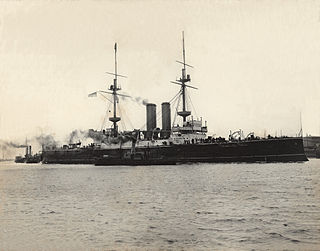
The Home Fleet was a fleet of the Royal Navy that operated from the United Kingdom's territorial waters from 1902 with intervals until 1967. In 1967, it was merged with the Mediterranean Fleet creating the new Western Fleet.

The Cruiser Squadron was a naval formation of the British Home Fleet consisting of Armored cruisers of the Royal Navy from 1899 to 1905.

The Atlantic Fleet was a naval fleet of the Royal Navy. It existed for two periods; 1909 until 1914, and then 1919 until 1932.

The Channel Fleet and originally known as the Channel Squadron was the Royal Navy formation of warships that defended the waters of the English Channel from 1854 to 1909 and 1914 to 1915.
The 6th Battle Squadron was a squadron of the British Royal Navy consisting of Battleships serving in the Grand Fleet and existed from 1913 to 1917.

The Battle Cruiser Fleet, (BCF), later known as Battle Cruiser Force, a naval formation of fast battlecruisers of the Royal Navy, operated from 1915 to 1919.

The 7th Battle Squadron was a squadron of the British Royal Navy assembled prior to World War I it was assigned to the Third Fleet and consisted of pre-dreadnought type battleships the oldest ships in fleet it existed from 1912 to 1914.

The 8th Battle Squadron was a squadron of the British Royal Navy assembled prior to the beginning of World War I; it was later assigned to the Third Fleet. The squadron consisted of pre-dreadnought type battleships. It existed from 1912 to 1914.
The 1st Division was a formation of the Home Fleet of the Royal Navy. It briefly existed before the First World War from 1909 to 1912.
The 2nd Division was a naval formation of the British Home Fleet it was formed before First World War in March 1909 and was active until May 1912.

The Naval Artillery and Torpedoes Division was a Directorate of the British Admiralty, Naval Staff that was created in June 1918 to decide weapons employment policy and also to develop weapon requirements. This division was also responsible for requirements for ship protection against weapons. It existed until 1920 when its responsibilities were divided into two new directorates, the Gunnery Division and the Torpedo Division.

The 4th Light Cruiser Squadron was a naval formation of Light cruisers of the Royal Navy from 1915 to 1919.

The 2nd Cruiser Squadron was a formation of cruisers of the British Royal Navy from 1904 to 1919 and from 1921 to 1941 and again from 1946 to 1952.

The 6th Cruiser Squadron was a formation of cruisers of the British Royal Navy from 1909 to 1915 and again from 1925 to 1945.

The 9th Cruiser Squadron was a formation of cruisers of the Royal Navy from 1912 to 1919 and again from 1939 to 1940. Cruiser squadrons consisted of five to six ships in wartime and in peacetime as low as two to three ships. From 1914 until 1924/25 they were designated as Light Cruiser Squadrons then after 1925 redesignated as Cruiser Squadrons.

The 11th Cruiser Squadron and also known as Cruiser Force E was a formation of cruisers of the British Royal Navy from 1914 to 1917 and again from 1939 to 1940.

The 12th Cruiser Squadron also known as Cruiser Force G was a formation of cruisers of the British Royal Navy from 1914 to 1915 and then again from 1939 to 1943.
The 1st Destroyer Flotilla, also styled as the First Destroyer Flotilla, was a naval formation of the British Royal Navy from 1909 to 1940 and again from 1947 to 1951.
The British 3rd Destroyer Flotilla, also styled as Third Destroyer Flotilla, was a naval formation of the Royal Navy from 1909 to 1939 and again from 1945 to 1951.

The British 3rd Aircraft Carrier Squadron also called Third Aircraft Carrier Squadron was a military formation of Aircraft Carriers of the Royal Navy from January 1948 to July 1952.




